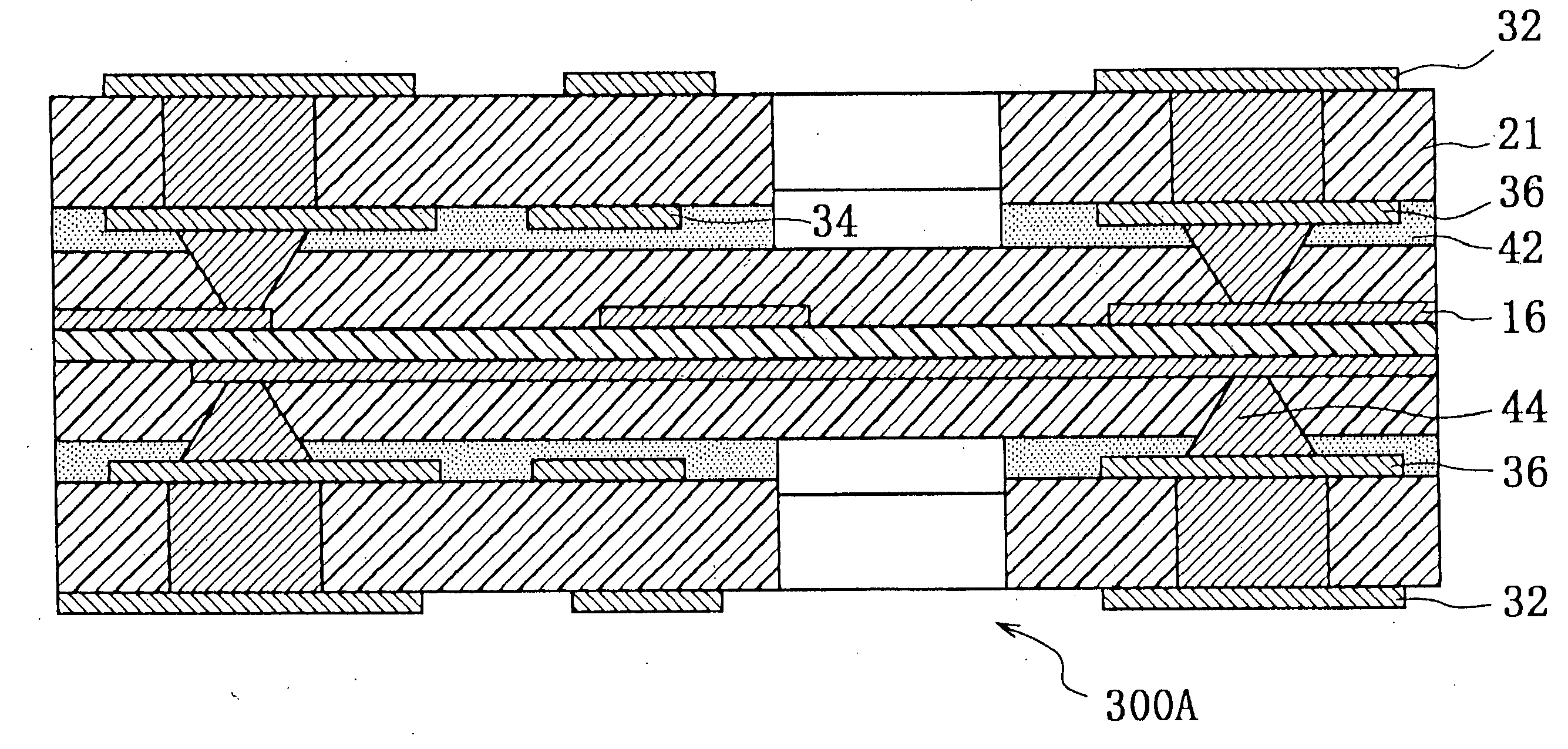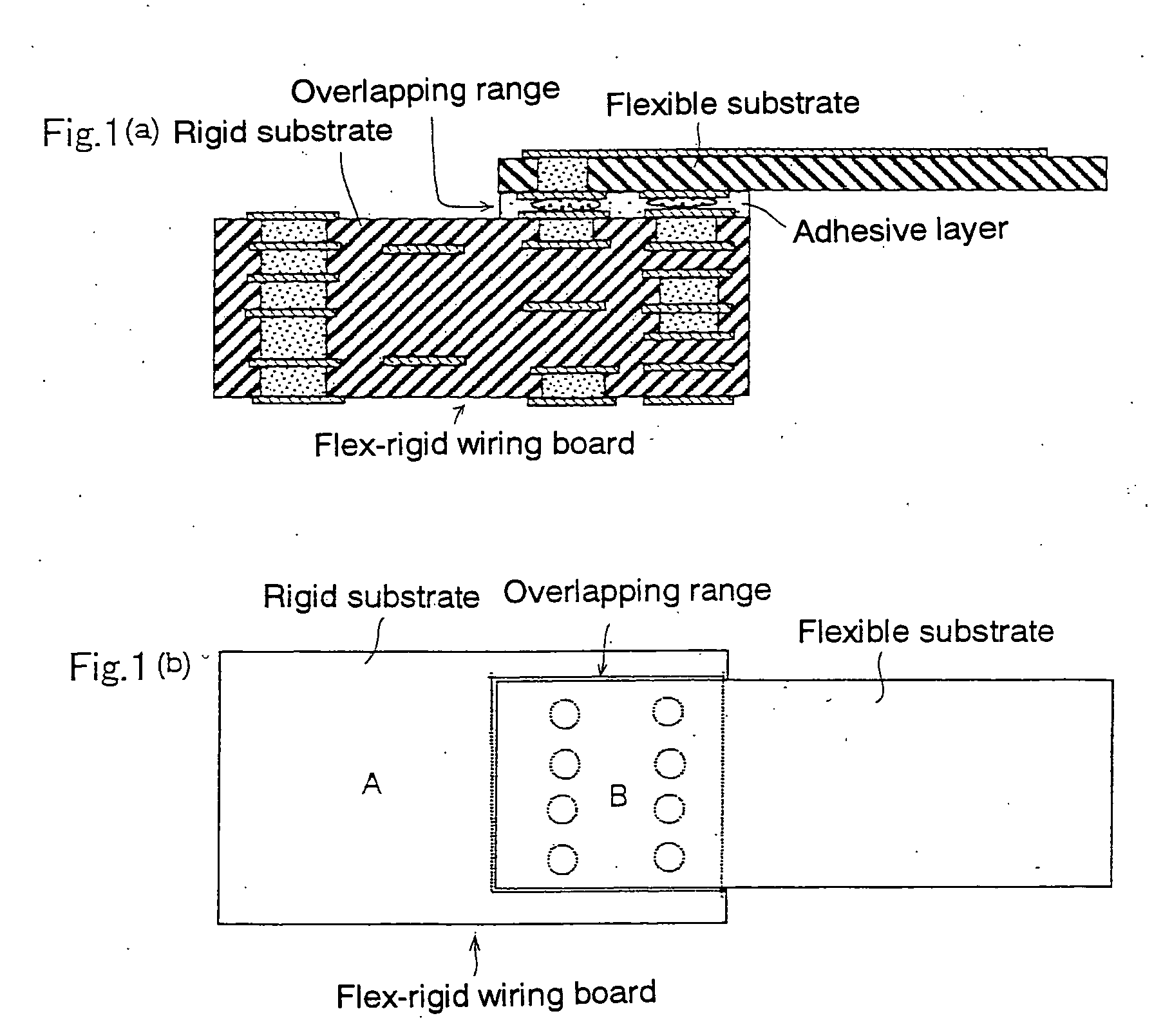Rigid-flex wiring board
a technology of rigid substrates and wiring boards, which is applied in the field of rigid rigid substrate wiring boards, can solve the problems of inability to produce any higher yield, scratching of rigid substrate surfaces, and relatively long time-consuming process, and achieves the effects of reducing inductance, high reliability, and high freedom of wiring
- Summary
- Abstract
- Description
- Claims
- Application Information
AI Technical Summary
Benefits of technology
Problems solved by technology
Method used
Image
Examples
example 1
[0139] (A) Preparation of a Flexible Substrate
[0140] (1) For manufacturing the flex-rigid wiring board according to the present invention, a laminated film (ESPANEX SB by Shin-Nittetsu Chemicals) including a 25 μm-thick insulative film 11 of polyimide resin having an 18 μm-thick copper foil 12 laminated on either side thereof (as in FIG. 2(a)) was used as a base material for preparation of a flexible substrate 100A included in the flex-rigid wiring board.
[0141] (2) The copper foil 12 laminated on either side of the insulative film 11 was etched using a cupric chloride aqueous-solution to form patterns 13 and 250 μm-diameter interconnecting electrode pads 16. A photosensitive epoxy resin (FR-5538EA by Hitachi Chemical) was applied to the wiring pattern, dried at 80° C. for 3 hours, then exposed to ultraviolet rays, and developed using dimethyleneglycol diethylether to form a 25 μm-thick resin cover layer 14 which has 300 μm-diameter openings 15 formed therein and protects the patte...
example 2
[0153] (A) Preparation of a Flexible Substrate
[0154] (1) For manufacturing the flex-rigid wiring board according to the present invention, a laminated film (ESPANEX SB by Shin-Nittetsu Chemicals) including a 25 m-thick insulative film 11 of polyimide resin having an 18 μm-thick copper foil 12 laminated on either side thereof was used as a base material for preparation of a flexible substrate included in the flex-rigid wiring board.
[0155] (2) The copper foil 12 laminated on either side of the insulative film 11 was etched using a cupric chloride aqueous-solution to form patterns 13, and a cresol-novolak epoxy resin (by Nihon Kayaku) of 60% by weight solved in dimethylglycol dimethylether was applied to the patterns 13. The resin was dried at 80° C. for 3 hours to form an uncured epoxy resin layer 50 (adhesive layer). Thus, a flexible substrate 100B was prepared.
[0156] (B) Preparation of a Rigid Substrate
[0157] (1) In a 0.11 mm-thick single-sided copper-clad laminate (as in FIG. 6...
example 3
[0169] (A) Preparation of a Flexible Substrate
[0170] (1) For manufacturing the flex-rigid wiring board according to the present invention, a laminated film (ESPANEX SB by Shin-Nittetsu Chemicals) including a 25 μm-thick insulative film 11 of polyimide resin having an 18 μm-thick copper foil 12 laminated on either side thereof was used as a base material for preparation of a flexible substrate included in the flex-rigid wiring board.
[0171] (2) The copper foil 12 laminated on either side of the insulative film 11 was etched using a cupric chloride aqueous-solution to form patterns 13, and a novolak epoxy resin (by Nihon Kayaku) of 60% by weight solved in dimethylglycol dimethylether was applied to the patterns 13. The resin was dried at 80° C. for 3 hours to form an uncured epoxy resin layer 50. Thus, a flexible substrate was prepared.
[0172] (B) Preparation of a Rigid Substrate
[0173] (1) In a 0.11-mm single-sided copper-clad laminate (as in FIG. 6(a)) including a substrate 21 of g...
PUM
 Login to View More
Login to View More Abstract
Description
Claims
Application Information
 Login to View More
Login to View More - R&D
- Intellectual Property
- Life Sciences
- Materials
- Tech Scout
- Unparalleled Data Quality
- Higher Quality Content
- 60% Fewer Hallucinations
Browse by: Latest US Patents, China's latest patents, Technical Efficacy Thesaurus, Application Domain, Technology Topic, Popular Technical Reports.
© 2025 PatSnap. All rights reserved.Legal|Privacy policy|Modern Slavery Act Transparency Statement|Sitemap|About US| Contact US: help@patsnap.com



